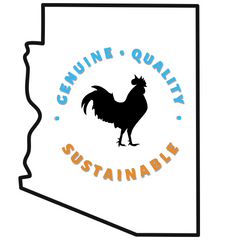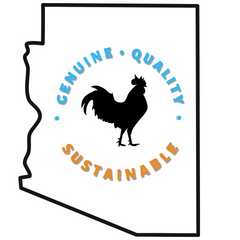Buy Complete Beginner Chicken Coop Setup (Southwest Edition)
Buy Complete Beginner Chicken Coop Setup (Southwest Edition)
A first chicken coop should wear like a luxury suit in the Arizona sun: expertly tailored for your climate, breathable where it counts, and built from quality materials that hold their shape season after season. In the Southwest, ventilation is your best fabric, shade is your lining, and craft decisions determine comfort, safety, and long-term value. Below, you’ll find a complete, practical buyer’s guide—rooted in hot-climate expertise and a “buy once, buy well” philosophy that prizes craftsmanship the way Italian tailoring prizes fit and finish.
Use this guide end‑to‑end or jump to what you need now. The summary highlights the essentials; the sections that follow add detail, examples, and simple planning tools you can put to work today.
Key takeaways / Summary
- Budget tiers for a complete beginner setup (typical ranges for planning):
- Starter Around $300: small flock, simple open-air frame, basic waterer/feeder, shade-first siting.
- Mid-range Around $800: sturdier frame, larger cross-ventilation, reflective roof/shade sail, easy-clean waterer, secure hardware cloth.
- Premium $2,000+: pro-built structure, high roofline, welded-wire run, predator hardware, reflective or insulated roof, automatic doors, shaded hydration station.
- What matters most in the Southwest:
- Ventilation-first design and high rooflines—see the Hot-climate coop ventilation guide.
- Shade and radiant control (trees, shade sails, reflective roofing)—see Sustainable cooling and shade strategies.
- Heat-stable water management and easy refresh cycles.
- Breeds: Pair your setup with heat-hardy birds to reduce losses—start with the Best heat-resistant chicken breeds and the Comprehensive heat-hardy buying guide.
- Avoid these common beginner mistakes: over-insulating, under-ventilating, placing the coop in full sun, and delaying predator-proofing. Learn more in the Hot-climate coop ventilation guide.
- Setup timeline: Brooder first, then coop/run, then nests/roosts before outdoor move-out—follow the Chick care timeline and outdoor transition.
- Health planning: Source vaccinated birds and prep biosecurity—review the Arizona Marek’s disease guidance.
- Begin with started pullets or robust chicks for the smoothest first season—see Choose your starter flock.
1) Needs assessment: space, flock size, budget tiers
Right sizing and budgeting are the backbone of a complete setup. In hot climates, err on the side of more air and more shade, much like choosing a breathable, high-twist wool over a heavy fabric in summer. A “tailored fit” coop balances flock size, daily routine, and your yard’s microclimate.
- Coop space (Southwest rule of thumb): 5–6 sq ft per bird to preserve airflow and reduce heat load.
- Run space: 10–15 sq ft per bird, ideally with dappled shade or shade sail coverage.
- Height: Taller rooflines vent heat better—think of a high back and armhole on a jacket that allows movement and breathability.
Add two quick considerations before you buy lumber or a kit: orient the largest screened openings toward prevailing breezes, and plan a working height you can stand under (6–7 ft in the run, if possible) for easier cleaning and better heat exhaust.
These are planning ranges, not product quotes. For comfort and cleaning, target a run height near 6 ft and site the coop where afternoon shade is strongest.
Budget tiers: What you can expect
If your setup budget is tight, you’ll often see better outcomes by choosing heat-hardy breeds and investing in shade/water management rather than overspending on enclosure insulation. See the Best heat-resistant chicken breeds for breed choices that fit a simple, breathable coop.
2) Hot climate coop essentials (AZ/Southwest)
In summer, airflow solves problems insulation cannot. In line with the Hot-climate coop ventilation guide, choose open-air, well-ventilated designs with shaded water and reflective elements where possible. The goal is a structure that “wears light,” like a summer-weight suit—structure and durability without trapping heat.
- Cross-ventilation: Large, opposite wall openings protected by hardware cloth. Position roosts in the airflow path but away from drafts in shoulder seasons.
- High roofline: Hot air rises; a taller peak or monitor-style vent lets heat escape.
- Shade-first siting: Use trees, building shade, or sails; reflective roofing can lower radiant load—see Sustainable cooling and shade strategies.
- Water management: Heat-stable waterers in the shade, frequent refreshes, and hoses within easy reach. This is a life-safety item in extreme heat.
- Materials: Favor weather-stable woods, galvanized or powder-coated hardware, UV-stable panels, and welded-wire for runs. Quality materials age like a well-made jacket—hold their shape, resist sag, and perform in heat.
Two Southwest add-ons that help: a min/max thermometer in the coop to verify airflow improvements, and a small “heat emergency plan” (backup waterer, electrolytes on hand, and a shaded, ventilated crate for any bird showing distress).
3) Complete equipment checklist (beginner-friendly, hot-climate ready)
Use this list to plan a complete setup from day one. When ready, compare options using the Beginner starter kit checklist and housing tips in the Hot-climate coop ventilation guide.
Coop & Run
Water & Feed
Bedding & Maintenance
Health & Safety
4) Heat-hardy breed recommendations
Choosing breeds that thrive in heat is as impactful as upgrading your roof vents. Mediterranean and desert-adapted birds typically handle Arizona summers better—fewer losses, steadier production, and calmer afternoons. Start with the curated lists at Best heat-resistant chicken breeds, and go deeper with the Comprehensive heat-hardy buying guide.
- Prioritize lighter-bodied, active foragers with large combs (better heat dissipation).
- If egg color is a preference (blue/green), cross-reference heat-tolerant lines with your egg basket goals.
- For beginners, started pullets or robust chicks reduce the learning curve—see Choose your starter flock.
5) Step-by-step setup timeline (printable)
-
Week 0–1: Plan, site, and shade
- Pick a coop location with morning sun and afternoon shade, or plan shade sails/reflective roofing.
- Map airflow: place large openings on opposing sides for cross-ventilation.
- Check local rules (if applicable): HOA, setbacks, and predator fencing allowances.
- Order supplies and, if applicable, reserve birds (prefer started pullets or robust chicks for beginners).
-
Week 1–2: Brooder and biosecurity
- Set up brooder indoors/garage with safe heat, draft control, and easy-clean surface.
- Vaccinated birds if needed; review Arizona Marek’s disease guidance.
- Prepare a quarantine plan if adding birds to an existing flock.
-
Week 2–3: Build coop and run (ventilation-first)
- Install high roofline or gable/monitor vents; screen all openings with hardware cloth.
- Add shade features and place waterers where they won’t heat up.
- Secure door hardware and predator apron/skirt around the run perimeter.
-
Week 3–5: Outdoor acclimation
- As birds feather out and nights are warm, begin supervised outdoor time and gradual transitions.
- Place roosts to catch breezes; verify nesting box height and shade before first eggs.
- Do a midday “heat check” rehearsal: confirm shade coverage and water temp after 2–3 hours of sun.
-
Week 5+: Routine and refinement
- Refresh water multiple times daily during heat waves; add backup water capacity.
- Dial in shade angles and reflective elements as the sun shifts seasonally—see Sustainable cooling and shade strategies.
- Keep simple notes on what worked; adjust roost placement, shade, and waterers accordingly.
6) Common mistakes (and how to avoid them)
- Over-insulating, under-ventilating. In hot climates, airflow outranks insulation. See the Hot-climate coop ventilation guide.
- Full sun siting with no radiant control. Use tree shade, sails, or reflective roofing—practical tips at Sustainable cooling and shade strategies.
- Underestimating water management. A shaded, easy-clean waterer and frequent refresh cycles are life-safety items in heat.
- Moving chicks out too soon without predator-proofing. Review the Chick care timeline and outdoor transition.
- Skipping health planning. Know your local disease context—start with the Arizona Marek’s disease guidance.
- Incubation projects in peak heat (first season). Delay until your system is proven—see Breeding & incubation in heat.
- Relying on chicken wire alone. Use ½ inch hardware cloth or welded wire for security; chicken wire is not predator-proof.
7) Product recommendations: how to buy like a craftsperson
While specific models and prices vary seasonally, you can still buy “like a tailor” and focus on the build decisions that determine longevity and flock comfort. Use the principles below alongside the Beginner starter kit checklist to compare items without overbuying.
- Coop body: Choose sturdy frames with high rooflines, large screened openings, and easy-clean floors. Avoid designs that look sealed like winter cabins.
- Run security: Prefer welded-wire or ½-inch hardware cloth, tight staples, predator-rated latches, and a buried apron.
- Roofing: Reflective panels or light-colored roofs reduce radiant load. Inspect drip edges and fasteners—quality hardware matters in monsoon winds.
- Waterers: Heat-stable plastics or metal, shaded placement, and easy dump/refresh. Consider redundant capacity for extreme days.
- Nest boxes: Removable trays, shade, and ventilation. Smooth interior surfaces clean faster.
FAQ: materials, craftsmanship, and value
Q: What materials are best for heat durability?
A: Weather-stable woods, galvanized or powder-coated steel hardware, UV-stable panels, and welded-wire run components. These hold shape, resist UV breakdown, and clean easily in summer routines.
Q: Should I insulate?
A: In the Southwest, prioritize ventilation, shade, and reflective roofing before insulation. Many new owners find insulation unnecessary when airflow and shade are correctly implemented.
Q: How many nesting boxes and roosting bars do I need?
A: Aim for 1 nesting box per 3–4 hens. Provide roosts above nest height with airflow around birds—never directly under roof peaks that trap heat without venting.
Q: What about automatic doors?
A: Useful quality-of-life upgrade at mid/premium tiers. Ensure the opening aligns with shade and ventilation plans, and test during monsoon winds.
Q: Do misters or fans help?
A: Shade and water management come first. In extreme heat, intermittent misting at the run’s edge (not inside the coop) can reduce radiant load; avoid creating damp, stagnant air. Fans should assist cross-ventilation, not replace it. Evap coolers are a good choice, AC for the pampered pets. If the coop/run is built right neither are necessary.
Q: How do I keep water cooler for longer?
A: Use opaque reservoirs, keep them fully shaded, refresh often, and position lines off hot ground. On peak days, add a second waterer on the opposite side of the run so birds never have to cross full sun to drink.
Putting it all together: a luxury-suit approach on any budget
Whether you spend ~$300 or ~$2,000+, the fundamentals don’t change: ventilation over insulation, shade over sheen, and water management above all. Like a well-made suit, the “fit” (sizing and airflow) and “fabric” (quality materials) matter more than ornamentation. Buy a coop that’s cut for your climate, then accessorize with shade and water resilience. When you’re ready to select birds, align breed traits with your setup using the Best heat-resistant chicken breeds and finalize timing with the Chick care timeline and outdoor transition.
References and further reading
- Hot-climate coop ventilation guide
- Sustainable cooling and shade strategies
- Best heat-resistant chicken breeds
- Comprehensive heat-hardy buying guide
- Chick care timeline and outdoor transition
- Choose your starter flock
- Arizona Marek’s disease guidance
- Breeding & incubation in heat
- Beginner starter kit checklist


